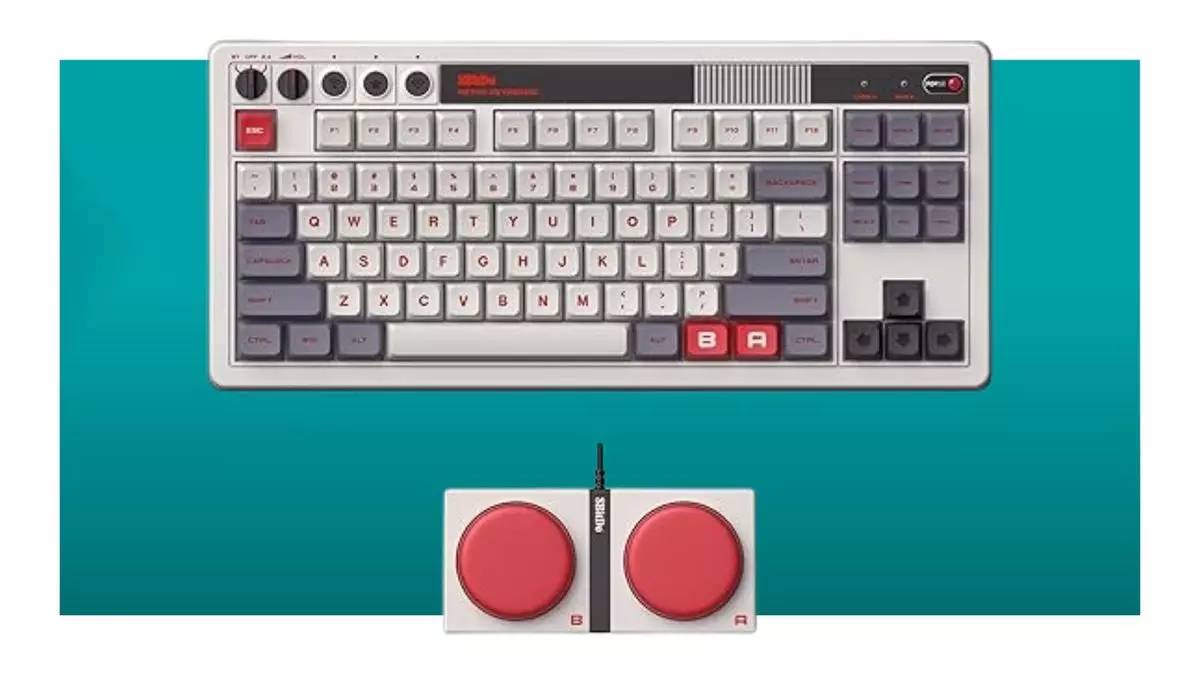In a world where gaming peripherals often seem indistinguishable from one another, the 8BitDo Retro Mechanical Keyboard manages to stand out through its nostalgic design while simultaneously offering modern features. The choice between the C64 and NES-themed keyboards might spark debate among enthusiasts, but one thing remains clear: both versions encapsulate a deep reverence for gaming history. While I can wholeheartedly recommend the C64 model to die-hard fans of the classic console, the NES version makes a compelling case for itself with its slightly lower price point and equally impressive features.
Price Point and Value Proposition
At an affordable $80, the NES-themed keyboard finds itself comfortably situated in the budget-friendly category of mechanical keyboards, making it an enticing option for gamers who appreciate both aesthetics and performance. Priced notably lower than its C64 counterpart, users can experience the charm of 8BitDo’s retro wave without breaking the bank. This pricing strategy effectively invites a wider audience to indulge in the nostalgic vibe without sacrificing functionality.
What’s crucial here is that while the keyboard serves as a stylish peripheral, it’s not merely about the visuals. Combining aesthetics with utility solidifies its value. A keen gamer might find themself reaching for the NES variant not only for its visual appeal but also for its robust features that cater to everyday gameplay. This thoughtful blend of style and substance makes it appeal to a broader spectrum of users—from the casual fans to the hardcore gamers.
Connectivity and Versatile Gameplay
One standout feature that defines the 8BitDo Retro range is its flexibility in connectivity. With seamless transitions between 2.4 GHz wired play and Bluetooth functionality, gamers can choose the setup that suits their needs best. The inclusion of a USB receiver tucked conveniently at the back of the keyboard enhances accessibility, allowing easy plug-and-play without the clutter of wires. For those who prioritize a wireless experience, Bluetooth mode, albeit with minor latency, opens the door for more relaxed gaming sessions.
Navigating through these modes is achieved with a simple turn of a dedicated dial located at the top left corner, a feature that feels intuitively designed yet delightful in its simplicity. This attention to user experience significantly elevates the overall gaming experience, allowing effortless switching between modes to accommodate different gameplay styles.
Ergonomics and Daily Usability
Over my time testing the keyboard, I was genuinely impressed by how retractable the demands of my daily work blended seamlessly with gaming. The smooth typing feel contributes to an ergonomic experience that eases extended use, allowing you to transition between intense gaming and regular typing without discomfort. Having used it for more than a month, I often preferred it over premium models that cost significantly more, thanks to its comfort and responsive feel.
Moreover, the innovative ‘Super Buttons’—large, programmable keys that allow users to customize game commands—display an impressive level of forward-thinking design. While the niche usage of these buttons might not resonate with every gamer, those who prioritize quick access to in-game functions can effectively reprogram them to activate essential shortcuts. In my case, having one button to start a recording stream and another to capture gameplay is nothing short of revolutionary.
Limitations and Software Constraints
However, it’s worth noting that the clever design of the Super Buttons isn’t without its drawbacks. The accompanying software for key customization lacks depth and can be frustratingly restrictive, sometimes leading to hurdles in executing certain key combinations. While the keyboard remains functional without the additional software, for those who wish to explore more advanced configurations, navigating these limitations can be a source of frustration.
This said, the inclusion of a ‘Super Stick’ provides an interesting layer of complexity for the C64 variant, adding a joystick functionality with automatic key programming. Yet, its practicality may leave some users questioning its necessity—especially when the NES edition already delivers a visually stunning and high-quality experience at a lower price.
The 8BitDo Retro Mechanical Keyboard has successfully carved its niche in the market, one that balances nostalgia, functionality, and cutting-edge design. Whether you gravitate towards the C64 version or prefer the NES aesthetics, it’s clear that both models represent a significant stride in gaming peripherals, enhancing not only performance but also the overall gaming environment.

